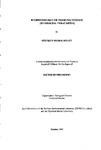ECOPHYSIOLOGY OF NEOMYSIS INTEGER (MYSIDACEA: PERACARIDA)
| dc.contributor.author | ROAST, STEPHEN DEREK | |
| dc.contributor.other | School of Biological and Marine Sciences | en_US |
| dc.date.accessioned | 2013-11-19T08:39:12Z | |
| dc.date.available | 2013-11-19T08:39:12Z | |
| dc.date.issued | 1997 | |
| dc.identifier | NOT AVAILABLE | en_US |
| dc.identifier.uri | http://hdl.handle.net/10026.1/2746 | |
| dc.description.abstract |
Neomysis integer (Leach) (Peracarida: Mysidacea) is a common component of the hyperbenthos of Western European estuaries, and this study focused on the ecophysiology and ecotoxicology of this mysid. Behavioural and physiological responses of N. integer to physical and chemical variables (current velocity, substratum type, temperature and salinity) were measured in the laboratory to gain better understanding of how this mysid maintains position in estuaries. Current velocity was the most important factor controlling position maintenance, and N. integer had a maximum swimming speed of c. 9cm sˉ¹. Position maintenance was facilitated by a muddy substratum and was not affected by salinity. Oxygen consumption and feeding rates of N. integer increased with increasing temperature but, whilst oxygen consumption decreased with increasing salinity, feeding rate increased. Male mysids consumed oxygen at a higher rate than females, however, there was no difference in the feeding rates of males and females. The acute toxicity of two organophosphate pesticides (chlorpyrifos and dimethoate) to N. integer was examined, and 96h LC50 values of 0.13µg chlorpyrifos Lˉ¹ and 0.54mg dimethoate Lˉ¹ were estimated. Sub-lethal exposure to chlorpyrifos led to an increased rate of oxygen consumption and decreased feeding rates compared with control animals. In addition, chlorpyrifos exposure led to disrupted behaviour of N. integer, including hyperactivity and decreased maximum swimming speed. The results are discussed in terms of the behaviour and physiology of N. integer in response to natural and anthropogenic physical and chemical variables in the natural environment. The potential of N. integer as a toxicity testing species, and the sublethal responses used in the study, are critically assessed. | en_US |
| dc.description.sponsorship | Brixham Environmentall Laboratory (ZENECA Limited) and the Plymouth Marine Laboratory | en_US |
| dc.language.iso | en | en_US |
| dc.publisher | University of Plymouth | en_US |
| dc.title | ECOPHYSIOLOGY OF NEOMYSIS INTEGER (MYSIDACEA: PERACARIDA) | en_US |
| dc.type | Thesis | |
| plymouth.version | Full version | en_US |
| dc.identifier.doi | http://dx.doi.org/10.24382/3733 | |
| dc.identifier.doi | http://dx.doi.org/10.24382/3733 |
Files in this item
This item appears in the following Collection(s)
-
01 Research Theses Main Collection
Research Theses Main


